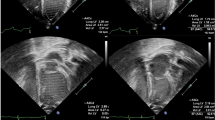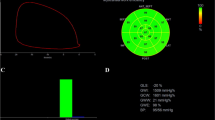Abstract
To assess the value of parameters of myocardial work for dynamic monitoring of myocardial injury after neonatal asphyxia. Fifty-three neonates with asphyxia admitted within 24 h after delivery were divided into a mild asphyxia group (n = 40) and severe asphyxia group (n = 13). Echocardiography was performed within 24 h post-birth, within 72 h post-birth (48 h after first echo), and during recovery. The left ventricular ejection fraction on M-mode echocardiography and by Simpson’s biplane method (LVEF and Bi-EF, respectively), stroke volume (SV), cardiac output (CO), cardiac index (CI), global longitudinal strain (GLS), global work index (GWI), global constructive work (GCW), and other parameters were measured. Echocardiographic indicators were compared between groups and over time. GWI was significantly increased at 72 h in the mild asphyxia group (P < 0.05) but showed no significant change over time in the severe asphyxia group (P > 0.05). While GCW increased significantly over time in both groups (P < 0.05), it increased earlier in the mild asphyxia group. Time and grouping factors had independent effects on GWI and GCW (P > 0.05). The characteristics of differences in GWI and GCW between the two groups were different from those for LVEF, Bi-EF, SV, CO, CI, and GLS and their change characteristics with improvement from treatment. GWI and GCW changed significantly during recovery from neonatal asphyxia, and their change characteristics differed between mild and severe asphyxia cases. Myocardial work parameters can be used as valuable supplements to traditional indicators of left ventricular function to dynamically monitor the recovery from myocardial injury after neonatal asphyxia.



Similar content being viewed by others
Data Availability
The datasets used and/or analyzed during the current study are available from the corresponding author on reasonable request.
References
Yu RJ, Ye HM, Zhu JX (2016) Expert consensus on the diagnosis of neonatal asphyxia. Chinese J Perinat Med 19(01):3–6
Chen ZL, Liu J, Feng ZC (2013) Recommendation on the diagnosis and classification standard of neonatal asphyxia. Chinese J Contemp Pediatr 15(01):1
Shah P, Riphagen S, Beyene J, Perlman M (2004) Multiorgan dysfunction in infants with post-asphyxial hypoxic-ischaemic encephalopathy. Arch Dis Child Fetal Neonatal Ed 89:F152–F155
Hankins GD, Koen S, Gei AF, Lopez SM, Van Hook JW, Anderson GD (2002) Neonatal organ system injury in acute birth asphyxia sufficient to result in neonatal encephalopathy. Obstet Gynecol 99:688–691
Shankaran S, Woldt E, Koepke T, Bedard MP, Nandyal R (1991) Acute neonatal morbidity and long-term central nervous system sequelae of perinatal asphyxia in term infants. Early Human Dev 25:135–148
Joynt C, Cheung PY (2018) Cardiovascular supportive therapies for neonates with asphyxia—a literature review of pre-clinical and clinical studies. Front Pediatr 6:363
Miao B, Sun B, Feng X (2012) Treatment of myocardial damage with creatine phosphate following neonatal asphyxia: a meta-analysis. Chinese J Contemp Pediatr 14(03):172–176
Kehl DW, Iqbal N, Fard A, Kipper BA, De La Parra LA, Maisel AS (2012) Biomarkers in acute myocardial injury. Trans Res J Lab Clin Med 159:252–264
Saenger AK, Jaffe AS (2007) The use of biomarkers for the evaluation and treatment of patients with acute coronary syndromes. Med Clin North Am 91(657–81):xi
Yu RJ, Wang JY, Liu SF (2016) Clinical diagnostic criteria of multiple organ damage in neonatal asphyxia. Chinese J Perinat Med 19(04):241–242
Bhasin H (2019) Echocardiographic assessment of myocardial dysfunction in perinatal asphyxia. Paediatr Int Child Health 39:304
Leone TA, Finer NN (2011) Shock: a common consequence of neonatal asphyxia. J Pediatr 158:e9-12
Wei Y, Xu J, Xu T, Fan J, Tao S (2009) Left ventricular systolic function of newborns with asphyxia evaluated by tissue Doppler imaging. Pediatr Cardiol 30:741–746
Russell K, Eriksen M, Aaberge L, Wilhelmsen N, Skulstad H, Remme EW et al (2012) A novel clinical method for quantification of regional left ventricular pressure-strain loop area: a non-invasive index of myocardial work. Eur Heart J 33:724–733
Lustosa RP, Fortuni F, van der Bijl P, Goedemans L, El Mahdiui M, Montero-Cabezas JM et al (2021) Left ventricular myocardial work in the culprit vessel territory and impact on left ventricular remodelling in patients with ST-segment elevation myocardial infarction after primary percutaneous coronary intervention. Eur Heart J Cardiovasc Imaging 22:339–347
Meimoun P, Abdani S, Stracchi V, Elmkies F, Boulanger J, Botoro T et al (2020) Usefulness of noninvasive myocardial work to predict left ventricular recovery and acute complications after acute anterior myocardial infarction treated by percutaneous coronary intervention. J Am Soc Echocardiogr Off Publ Am Soc Echocardiogr 33:1180–1190
Chan J, Edwards NFA, Khandheria BK, Shiino K, Sabapathy S, Anderson B et al (2019) A new approach to assess myocardial work by non-invasive left ventricular pressure-strain relations in hypertension and dilated cardiomyopathy. Eur Heart J Cardiovasc Imaging 20:31–39
Boe E, Russell K, Eek C, Eriksen M, Remme EW, Smiseth OA et al (2015) Non-invasive myocardial work index identifies acute coronary occlusion in patients with non-ST-segment elevation-acute coronary syndrome. Eur Heart J Cardiovasc Imaging 16:1247–1255
(2020) Guidelines for Clinical application of echocardiography in the assessment of cardiac systolic and diastolic function. Chinese J Ultrasonogr. 29(06):461–77
Lopez L, Colan SD, Frommelt PC, Ensing GJ, Kendall K, Younoszai AK, Lai WW, Geva T (2010) Recommendations for quantification methods during the performance of a pediatric echocardiogram: a report from the pediatric measurements writing group of the American society of echocardiography pediatric and congenital heart disease council. J Am Soc Echocardiogr 23(5):465–495
Dionne JM, Bremner SA, Baygani SK, Batton B, Ergenekon E, Bhatt-Mehta V et al (2020) Method of blood pressure measurement in neonates and infants: a systematic review and analysis. J Pediatr 221:23-31.e5
Lipshultz SE, Law YM, Asante-Korang A, Austin ED, Dipchand AI, Everitt MD et al (2019) Cardiomyopathy in children: classification and diagnosis: a scientific statement from the American heart association. Circulation 140:e9–e68
Gurgul S, Buyukakilli B, Komur M, Okuyaz C, Balli E, Ozcan T (2018) Does Levetiracetam administration prevent cardiac damage in adulthood rats following neonatal hypoxia/ischemia-induced brain injury? Medicina 54(2):12
Popescu MR, Panaitescu AM, Pavel B, Zagrean L, Peltecu G, Zagrean AM (2020) Getting an early start in understanding perinatal asphyxia impact on the cardiovascular system. Front Pediatr 8:68
Gill RS, Pelletier JS, LaBossiere J, Bigam DL, Cheung PY (2012) Therapeutic strategies to protect the immature newborn myocardium during resuscitation following asphyxia. Can J Physiol Pharmacol 90:689–695
Hedwig F, Nemchyna O, Stein J, Knosalla C, Merke N, Knebel F et al (2021) Myocardial work assessment for the prediction of prognosis in advanced heart failure. Front Cardiovasc Med 8:691611
Fanaroff JM, Fanaroff AA (2006) Blood pressure disorders in the neonate: hypotension and hypertension. Semin Fetal Neonatal Med 11:174–181
Jones JE, Jose PA (2004) Neonatal blood pressure regulation. Semin Perinatol 28:141–148
Batton B (2020) Neonatal blood pressure standards: what is “normal”? Clin Perinatol 47:469–485
Geyer H, Caracciolo G, Abe H, Wilansky S, Carerj S, Gentile F, Nesser HJ, Khandheria B, Narula J, Sengupta PP (2010) Assessment of myocardial mechanics using speckle tracking echocardiography: fundamentals and clinical applications. J Am Soc Echocardiogr 23(4):351–369
Mir TS, Laux R, Hellwege HH, Liedke B, Heinze C, von Buelow H et al (2003) Plasma concentrations of aminoterminal pro atrial natriuretic peptide and aminoterminal pro brain natriuretic peptide in healthy neonates: marked and rapid increase after birth. Pediatrics 112:896–899
Koch A, Singer H (2003) Normal values of B type natriuretic peptide in infants, children, and adolescents. Heart British Cardiac Soc 89:875–878
Zhu R, Nie Z (2016) A clinical study of the N-terminal pro-brain natriuretic peptide in myocardial injury after neonatal asphyxia. Pediatr Neonatol 57:133–139
Lin LX, Mao QH, Zhang ZL, An CX, Kang XG (2010) Plasma levels of N-terminal pro-brain natriuretic peptide and glycogen phosphorylase isoenzyme BB in neonates with asphyxia complicated by myocardial injury. Zhongguo Dang dai er ke za zhi= Chinese J Contemp Pediatr 12(4):252–255
Tomoaia R, Beyer RS, Zdrenghea D, Dadarlat-Pop A, Cismaru G, Gusetu G et al (2021) Global work index by non-invasive pressure-strain loops: a novel parameter to assess left ventricular performance in the early stages of heart failure with preserved or mid-range ejection fraction after acute myocardial infarction. Med Ultrason 23:62–69
Roger-Rollé A, Cariou E, Rguez K, Fournier P, Lavie-Badie Y, Blanchard V, Roncalli J, Galinier M, Carrié D, Lairez O (2020) Can myocardial work indices contribute to the exploration of patients with cardiac amyloidosis? Open Heart. 7(2):e001346
Hedwig F, Soltani S, Stein J, Schoenrath F, Potapov E, Knosalla C et al (2020) Global work index correlates with established prognostic parameters of heart failure. Echocardiogr Mount Kisco NY 37:412–420
Acknowledgements
This work was supported by the Gusu Health Talent Foundation [Grant Numbers GSWS2020054; GSWS2019048] and the Suzhou Science and Technology Bureau Science and Technology Development Plan [Grant Number SS2020066].
Author information
Authors and Affiliations
Contributions
X-LH: Conceptualization, Methodology, Writing- Original draft preparation. CH: Data curation. HW: Formal analysis. HL, TP: Supervision, Resources. J-CN, Y-YD: Software, Validation. X-YS, X-CL: Visualization, Investigation. Q-QX: Writing- Reviewing and Editing, Funding acquisition, Project administration.All authors reviewed the manuscript.
Corresponding author
Ethics declarations
Competing interests
The authors declare no competing interests.
Ethical Approval
This study was approved by the Ethics Committee of Children’s Hospital of Soochow University (2021CS151).
Informed Consent
Informed consent was obtained from legal guardians and the study protocol conforms to the ethical guidelines of the 1975 Declaration of Helsinki as reflected in a priori approval by the institution's human research committee.
Additional information
Publisher's Note
Springer Nature remains neutral with regard to jurisdictional claims in published maps and institutional affiliations.
Supplementary Information
Below is the link to the electronic supplementary material.
Rights and permissions
Springer Nature or its licensor (e.g. a society or other partner) holds exclusive rights to this article under a publishing agreement with the author(s) or other rightsholder(s); author self-archiving of the accepted manuscript version of this article is solely governed by the terms of such publishing agreement and applicable law.
About this article
Cite this article
Hu, XL., Hou, C., Wang, H. et al. Myocardial Work for Dynamic Monitoring of Myocardial Injury in Neonatal Asphyxia. Pediatr Cardiol (2023). https://doi.org/10.1007/s00246-023-03357-w
Received:
Accepted:
Published:
DOI: https://doi.org/10.1007/s00246-023-03357-w




